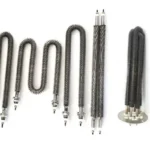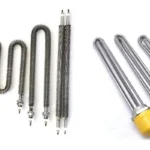Are you looking for a reliable and efficient heating solution? Have you heard about cartridge heaters but aren’t quite sure what they are?
Cartridge heaters are cylindrical heating elements used to heat metal parts by inserting them into drilled holes. They transfer heat through conduction, ensuring efficient and localized heating in various applications.
Let’s dive deeper into the world of cartridge heaters. I will share what I’ve learned over the years at ELEKHEAT. This guide will cover everything from their basic functions to advanced applications.
What are the key components of a cartridge heater?
Have you ever wondered what makes a cartridge heater work? It’s more than just a simple heating element.
The key components include a resistance wire (usually nichrome), ceramic insulation, a metallic sheath (often stainless steel), and a compacted filling material. These components work together to generate and transfer heat efficiently and safely.
Dive deeper:
Cartridge heaters are built with several important parts. Each part plays a role in how well the heater works.
Resistance Wire
This is the heart of the heater. The resistance wire, often made of nichrome, turns electrical energy into heat. When electricity flows through the wire, the wire resists the flow, creating heat.
Ceramic Insulation
The resistance wire is surrounded by ceramic insulation. This insulation keeps the wire from touching the sheath. It makes sure that the electricity flows only through the wire. This is important for safety and efficiency.
Metallic Sheath
The metallic sheath is the outer layer of the heater. It protects the internal parts and transfers heat to the material being heated. Stainless steel is often used because it is strong and resists corrosion.
Compacted Filling Material
The space between the resistance wire and the sheath is filled with a compacted material. This material helps transfer heat evenly and quickly. It also keeps the wire in place and protects it from vibration and shock.
All of these parts work together to make a reliable and efficient heater. At ELEKHEAT, we pay close attention to the quality of each part. This attention to detail ensures our heaters perform well.
How do you choose the right cartridge heater for your needs?
Choosing the right heater can seem hard. With so many options, how do you pick the best one?
Consider factors like wattage, voltage, size, sheath material, and operating temperature. Match these specifications to your application’s requirements for optimal performance and longevity.
Dive deeper:
To pick the right cartridge heater, you need to think about a few things. These things include wattage, size, material, and more.
Wattage
Wattage tells you how much heat the heater can produce. If you need to heat something quickly or keep it at a high temperature, you’ll need a higher wattage. If you only need to keep something warm, a lower wattage will work.
Size
The size of the heater needs to match the hole you’ll put it in. Measure the hole carefully to make sure the heater fits. A heater that is too big or too small won’t work well.
Sheath Material
The material of the heater’s outer layer is important. Stainless steel is common because it resists rust. Other materials might be better for very hot or corrosive environments.
Operating Temperature
You need to know the highest temperature the heater will reach. Make sure the heater is designed to handle that temperature. Using a heater above its temperature limit can be dangerous.
At ELEKHEAT, we can help you choose the right heater for your needs. We can talk about your project and help you find the perfect match. We’ve been doing this since 1997, so we know what works.
What are the different types of cartridge heaters available?
Did you know there’s more than one kind of cartridge heater? Each type has its own strengths and best uses.
Common types include standard, swaged, high-density, and miniature cartridge heaters. Swaged heaters offer better heat transfer and durability. High-density heaters provide more power in a smaller package. Miniature heaters are perfect for tight spaces.
Dive deeper:
There are many types of cartridge heaters. Each type has unique features. These features make them better for different jobs. Here are some common types:
Standard Cartridge Heaters
These are the most common type. They are used in many different applications. Standard heaters are good for general heating needs.
Swaged Cartridge Heaters
Swaged heaters are made by compressing the components tightly. This makes the heater more durable. It also improves heat transfer. Swaged heaters are good for demanding applications.
High-Density Cartridge Heaters
High-density heaters can produce a lot of heat in a small space. They are used when you need a lot of power but don’t have much room.
Miniature Cartridge Heaters
Miniature heaters are very small. They are used in tight spaces where a larger heater won’t fit.
Here’s a simple comparison table:
| Type | Features | Applications |
|---|---|---|
| Standard | Common, general use | Basic heating tasks |
| Swaged | Durable, better heat transfer | Demanding applications |
| High-Density | High power in small space | Limited space, high heat needs |
| Miniature | Very small | Tight spaces |
At ELEKHEAT, we make all these types of heaters. We can help you pick the best one for your project. We focus on quality and performance. This ensures you get the best heater for your money.
Conclusion
Cartridge heaters are versatile and reliable heating solutions. Understanding their components, types, and selection process will help you choose the best heater for your specific needs.









